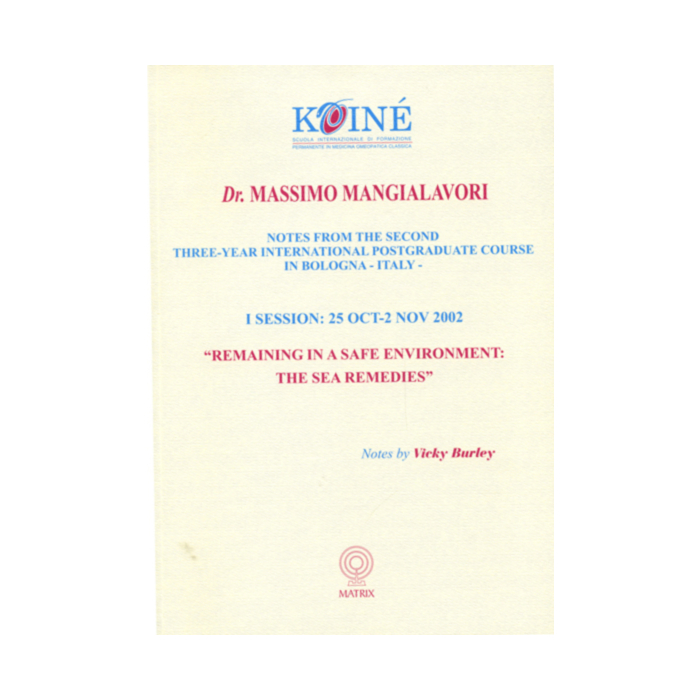Remaining in a Safe Environment: The Sea Remedies (notes vol 1)
Share on social media
Massimo's approach of homeopathic families and the concept of fundamental themes of homeopathic families is introduced. Fundamental themes should be present for a deeply curative prescription. Remedies presented through cases and discussion: Ambra grisea, Aqua marina, Asterias, Astacus, Badiaga, Calcarea carbonica, Corallium rubrum, Cypraea eglantina, Gadus morhua, Homarus, Limulus cyclops, Medusa, Murex, Oleum jecoris, Pecten, Sepia, Spongia, Venus, and similars. Calcium and related, Natrum and related, and some Halogens.
| ISBN | 9788888799063 |
|---|---|
| Author | Massimo Mangialavori |
| Type | Paperback |
| Language | English |
| Publication date | 2003 |
| Pages | 131 |
| Publisher | Matrix |
| Review | This book review is reprinted from the Autumn 2003, Vol. 16 (3) Edition with permission from Homeopathic Links. Reviewed by Annette Sneevliet MD, The Netherlands Massimo Mangialavori started a three year long, international, postgraduate course in 2002 to teach intensively his ideas about themes of families. Three times a year for a week, participants from all over the world met in Italy to study and learn to integrate Massimo's method in their daily practice. I can tell from my own experience how much I learned from this course, prescribing much more accurate and giving remedies I never would have thought of before, for instance from the group of sea remedies Medusa, Homarus, Aqua marina, etc. Or the Silicea-like remedies, such as Castor equi or Equisetum. Because of the great number of colleagues who wanted to join the three years course, Massimo started a second group of students, Who met two times a year for ten days intensive study. One of the participants of this group, Vicki Burley, made beautiful notes from the first ten days, titled 'Remaining in a safe environment: the sea remedies'. The notes contain 124 pages of information about sea remedies, including cases, and provide a good insight in Massimo's work with the themes of families. Of the sea remedies, several general themes are being discussed, and for each remedy these themes are being elaborated on more specifically (variations on the theme) and more unique characteristics are added. In the subsequent discussion of each remedy a line of development becomes clear in how more and more the safe environment of the sea and/or shell or armour is exchanged for the challenges and opportunities of a life on land. The remedies discussed in this book are: Spongia tosta, Corallium, Medusa, Asterias rubens, Limulus cyclops, Homarus gammarus, Astacus fluviatilis, Badiago, Gadus morrhua, Oleum jecoris Aselli, Venus mercenaria, Murex purpura, Pectum jacobaeus, Calcarea carbonica, Cypraea eglantina, Calcarea phosphorica, Calcarea sulphurica, Hepar sulphuris, Calcarea fluorica, Natrum muriaticum, Natrum iodatum, Natrum bromarum, Aqua marina, Ambra grisea and Sepia. In future the rest of the three years course will be made available in the same way. So all the information will be spread and can be used to improve one's way of prescribing. |
Review
This book review is reprinted from the Autumn 2003, Vol. 16 (3) Edition with permission from Homeopathic Links.
By: Vicki Burley
Reviewed by Annette Sneevliet MD, The Netherlands
Massimo Mangialavori started a three year long, international, postgraduate course in 2002 to teach intensively his ideas about themes of families. Three times a year for a week, participants from all over the world met in Italy to study and learn to integrate Massimo's method in their daily practice. I can tell from my own experience how much I learned from this course, prescribing much more accurate and giving remedies I never would have thought of before, for instance from the group of sea remedies Medusa, Homarus, Aqua marina, etc. Or the Silicea-like remedies, such as Castor equi or Equisetum. Because of the great number of colleagues who wanted to join the three years course, Massimo started a second group of students, Who met two times a year for ten days intensive study. One of the participants of this group, Vicki Burley, made beautiful notes from the first ten days, titled 'Remaining in a safe environment: the sea remedies'.
The notes contain 124 pages of information about sea remedies, including cases, and provide a good insight in Massimo's work with the themes of families. Of the sea remedies, several general themes are being discussed, and for each remedy these themes are being elaborated on more specifically (variations on the theme) and more unique characteristics are added. In the subsequent discussion of each remedy a line of development becomes clear in how more and more the safe environment of the sea and/or shell or armour is exchanged for the challenges and opportunities of a life on land. The remedies discussed in this book are:
Spongia tosta, Corallium, Medusa, Asterias rubens, Limulus cyclops, Homarus gammarus, Astacus fluviatilis, Badiago, Gadus morrhua, Oleum jecoris Aselli, Venus mercenaria, Murex purpura, Pectum jacobaeus, Calcarea carbonica, Cypraea eglantina, Calcarea phosphorica, Calcarea sulphurica, Hepar sulphuris, Calcarea fluorica, Natrum muriaticum, Natrum iodatum, Natrum bromarum, Aqua marina, Ambra grisea and Sepia.
In future the rest of the three years course will be made available in the same way. So all the information will be spread and can be used to improve one's way of prescribing.


